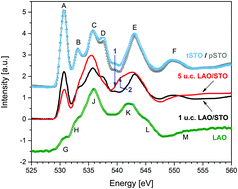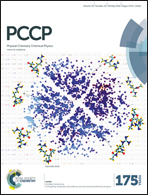Electronic defect states at the LaAlO3/SrTiO3 heterointerface revealed by O K-edge X-ray absorption spectroscopy†
Abstract
Interfaces of two dissimilar complex oxides exhibit exotic physical properties that are absent in their parent compounds. Of particular interest is insulating LaAlO3 films on an insulating SrTiO3 substrate, where transport measurements have shown a metal–insulator transition as a function of LaAlO3 thickness. Their origin has become the subject of intense research, yet a unifying consensus remains elusive. Here, we report evidence for the electronic reconstruction in both insulating and conducting LaAlO3/SrTiO3 heterointerfaces revealed by O K-edge X-ray absorption spectroscopy. For the insulating samples, the O K-edge XAS spectrum exhibits features characteristic of electronically active point defects identified as noninteger valence states of Ti. For conducting samples, a new shape-resonance at ∼540.5 eV, characteristic of molecular-like oxygen (empty O-2p band), is observed. This implies that the concentration of electronic defects has increased in proportion with LaAlO3 thickness. For larger defect concentrations, the electronic defect states are no longer localized at the Ti orbitals and exhibit pronounced O 2p–O 2p character. Our results demonstrate that, above a critical thickness, the delocalization of O 2p electronic states can be linked to the presence of oxygen vacancies and is responsible for the enhancement of conductivity at the oxide heterointerfaces.


 Please wait while we load your content...
Please wait while we load your content...